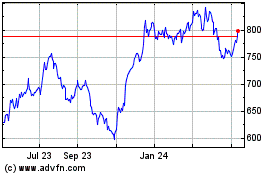What to Know About 'Nontransparent' ETFs -- Journal Report
May 05 2019 - 10:30PM
Dow Jones News
By Bailey McCann
You'll be hearing more about "nontransparent" exchange-traded
funds, now that the Securities and Exchange Commission is poised to
approve a wave of them.
ETFs are known for being transparent, in the sense that they
generally disclose their holdings daily. Nontransparent ETFs are a
new category that will allow asset managers to actively manage a
fund, as mutual-fund managers do, without having to disclose all of
the fund's investments every day. The idea is that nontransparency
will allow active ETF managers to pursue their investment
strategies without the risk that they will be foiled by the
market's reactions or copied by others if they have to reveal every
move they make.
Active managers say nontransparent ETFs will allow them to offer
the potential benefits of active management with the cost and tax
advantages of ETFs. But the lack of transparency has created
concerns about how accurately these funds' share prices will
reflect the funds' holdings on a daily basis.
The question of clarity
In April, the SEC approved an application from Precidian Funds
LLC for a nontransparent ETF structure called ActiveShares.
Precidian is partly owned by Legg Mason, which is licensing the
structure so that it can offer funds based on it. Fund providers
American Century, BlackRock, Capital Group, Columbia, Gabelli,
JPMorgan and Nuveen have all signed on to license ActiveShares,
indicating a wave of ETFs to come based on the structure.
Other providers also have filed for SEC approval of
nontransparent ETFs. The core focus of the SEC in relation to these
funds has been on intraday pricing and how positions are eventually
disclosed.
"There is a concern about the ability of market makers' ability
to quote accurate prices if they don't have a clear picture" of a
fund's holdings, says Ben Johnson, director of global ETF research
for research firm Morningstar Inc.
ActiveShares uses an authorized intermediary to provide daily
information on holdings to market makers, without making that data
available to the general public. "Our structure ensures that
authorized purchasers have all of the information they need to make
markets and limit risk," says Daniel McCabe, Precidian's chief
executive. "We also provide updated intraday pricing every second,
so the product behaves and should be treated like any other
ETF."
The other companies that have filed for approval of
nontransparent ETFs rely on various methods to get data on their
holdings to market makers, but Mr. Johnson notes that it's hard to
tell at this point how seamless that process will be.
Another concern has been that providers will have to work
closely with broker-dealers and financial advisers to help them
understand how the funds work. "One of the big obstacles here will
be the complexity," says Jeremy Held, director of research at
SS&C ALPS Advisors.
Mr. Held adds that while investors may not be fully dialed into
the debate over the structure of nontransparent ETFs, they are
likely to focus on the lack of transparency. These funds will be
under pressure to demonstrate a clear benefit to portfolios that
outweighs delayed disclosure of their holdings -- especially for
investors who aren't already in actively managed funds.
Nontransparent ETFs will also be going head-to-head against a
growing number of transparent active ETFs with established track
records.
The irony of 'active'
"One of the ironies here is that a major driver of growth in the
ETF space has been the underperformance of active management, which
pushed investors to seek lower-cost and easier-to-understand
options," Mr. Held says. Indeed both WisdomTree and Charles Schwab
have expressed skepticism about nontransparent ETFs to reporters
and analysts on recent earnings calls, citing lack of transparency
and performance concerns as key issues.
For investors who are already in actively managed mutual funds
and are therefore comfortable with a little less transparency,
asset managers are betting that the transition to opaque ETFs will
be straightforward.
However, Nick Elward, senior vice president and head of ETFs at
Natixis Investment Managers, says investors will want to look
closely at the tax implications before moving any money from mutual
funds to nontransparent ETFs. Mutual-fund investors may take a tax
hit from realizing unexpected capital gains when they sell their
shares. The benefits of switching over will have to outweigh those
initial costs.
"These products certainly give investors more choices for active
management," Mr. Elward says. "But it will be incumbent upon
managers to prove the benefits and that they can outperform
consistently. Investors are usually willing to trust if the track
record is there."
Ms. McCann is a writer in New York. She can be reached at
reports@wsj.com.
(END) Dow Jones Newswires
May 05, 2019 22:15 ET (02:15 GMT)
Copyright (c) 2019 Dow Jones & Company, Inc.
BlackRock (NYSE:BLK)
Historical Stock Chart
From Mar 2024 to Apr 2024

BlackRock (NYSE:BLK)
Historical Stock Chart
From Apr 2023 to Apr 2024
